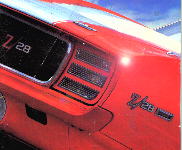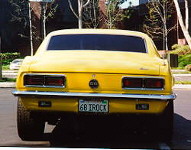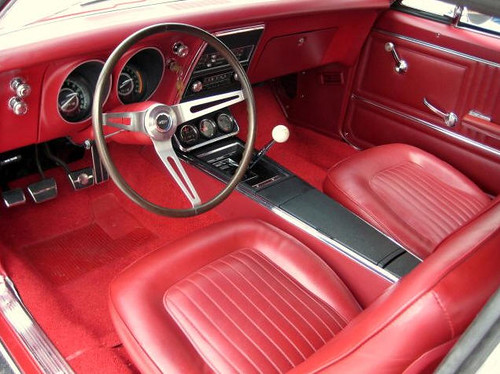
The name Z28 started out as only a Regular Production Order (RPO) option code but has since grown into one of the most recognizable three letters in Camaro automotive history. It may just be a coincidence that the RPO code for the Camaro Super Sport (SS) package was Z27 and that RPO Z28 just followed it sequentially or maybe not. Whatever the case may be it was nothing more and nothing less than a RPO option code at first.
Some people mistakenly believed that the Z in Z28 stood for Zora Arkus-Duntov the Corvette engineer. Actually a man named Vincent W. Piggins (more on him later) had put a name on the original 283 “Z28″ prototype Camaro before he presented it at a October 1966 “show-and-tell” session with top management at the GM Proving Grounds. The name that he had chosen was Cheetah. However at the last moment Vincent took the handmade decal off the car mumbling something like, “Well, a name is a name is a name.”
“There wasn’t any suggestion of what we were going to call this car,” recalls Vincent. “When it came down to having to decide, somebody just said, `Hey, it’s option RPO Z28; let’s call it Z28!’ So the name just grew from there. The graphics people did things with the Z, and that’s how the designation stuck. The car got its name from the actual option number.”
So who is Vincent W. Piggins you ask? Well he was a veteran Chevy engineer who designed the Z28 expressly for the Trans-America sedan series races along with convincing Chevrolet/GM management to sell it to the public. In fact, without Vincent’s efforts, the Sports Car Club of America’s (SCCA) might never have continued Trans-America sedan competition at all. Had it not been for Vincent’s assurance to SCCA officials that Chevrolet would lend its support there may not have been a Trans-Am sedan series race schedule for 1967.
Vincent had been a Chevrolet engineer since 1956 and was the man behind the Hudson Hornet’s NASCAR championships in the early 1950′s. The following is his explanation of the Z28′s creation:
“After Ford released the Mustang, they had about two years on us before Chevrolet could get the Camaro into the 1967 product line. I felt in my activity, which deals with product promotion and how to get the most promotional mileage from a car from the performance standpoint, that we needed to develop a performance image for the Camaro that would be superior to the Mustang’s.
“Along comes SCCA in creating the Trans-Am sedan racing class for professional drivers in 1966, aimed at the 1967 season. I made it a point to have several discussions with SCCA officials-notably Jim Kaser, John Bishop, and Tracy Byrd-and one thing led to another. I suggested a vehicle that would fit this class and, I believe … supported by what Chevrolet might do with the Camaro … it gave them heart to push ahead and make up the rules, regulations, and so forth for the Trans-Am series. I feel this was really the creation of the Trans-Am as we know it.”
“This was “sedan racing,” mind you, and what qualified the Camaro and all ponycars as “sedans” was the fact that they had rear seats. And although Chevrolet sold only 602 Z28′s during 1967, they met the 1000 production rule by homologating the 350-cid Camaro under FIA Group I rules and then qualifying the same basic vehicle with the Z28 option under Group II.”
“Now on August 16, 1966, ” continues Piggins, “I put together a memo to my boss, W.T. Barwell, that laid out the basic idea of the Z-28, although, of course, it wasn’t called that then.
“This memo went out to engineers Alex Mair and Don McPherson, sales manager Bob Lund, Joe Pike in sale promotion, and C.C. Jakust. I said, in effect, that SCCA sedan racing was becoming increasingly popular and would blossom into even bigger things with the advent of the short-wheelbase, Mustang type pony car.
“My proposal went on that since our projected engine lineup for the 1967 Camaro had no V-8 smaller than the 327, and since we were above the 5000cc (305-cid) SCCA displacement limit for Class A sedans, we ought to take a high-performance version of the old 283 and wrap an option package around it to make it competitive within SCCA. You’ll remember that the Barracuda was running a 273 V-8 at that time, and the Mustang’s competitive engine was the 289. So our high-performance 283 would certainly have been right in there.”
The key portions of Piggins’ Aug. 17 memo said, “A new 283 high-performance engine plus other relative drive line and chassis items will provide performance and handling characteristics superior to either Mustang or Barracuda. To aid in the merchandising of this vehicle, certain other embellishments have been included to make the overall vehicle immediately identifiable and distinctive. The sales department anticipates a volume of 10,000 such vehicles could be sold in 1967.”
Piggins continues his explanation: “My initial proposal suggested we use the 283 V-8 plus the F-41 optional suspension, with heavy-duty front coils and multi-leaf rear springs. I also requested the J-52 front disc brakes with J-65 metallic linings for the rear drums, the 11-inch clutch from the 396 V-8, the close-ratio 4-speed with 2.20 low, a brand-new steering gear with a 24:1 overall ratio, Corvette 15 x 6 wheels with 7.75 tires, and a special reworked hood to provide functional air intake. There were other modifications called for as well, and 1 suggested we make the package available only in the Camaro coupe, not the convertible, and that the Z-22 Rally Sport option form part of the equipment for this car. Now not all this equipment went into the production Z-28 automobile, but those were the initial parts called for.”
Piggins got permission to have a pre-production Z-28 prototype built to these initial specifications. One of his first passengers in the as-yet-unnamed Z-28 was Chevrolet’s new general manager, Elliott M. (Pete) Estes. The ride didn’t come until just before noon. After some full-throttle acceleration runs and a few dives through a slalom course, Piggins let Estes take the wheel.
“Estes was quite impressed with the performance of this 283 engined vehicle,” recalls Piggins, “and as I explained to him what we planned to do to capture the Trans-Am championship and to produce a good performance image for the Camaro, it didn’t take much convincing for Pete to see what I was aiming toward.
“The only thing. . .” says Vincent, “while we were driving the car, I mentioned that we’d put the 283 into it because we’d built that size engine before. But I suggested when we got back to the starting pad that it might be a lot better to take the 327 block and put the 283 crank into it, giving us a 4 x 3 bore and stroke. That would put displacement at 302.4 cid, just under the SCCA’s 305 limit.” This configuration produced a high revving 302 cid small-block with a modestly rated 290 bhp (probably more like 350hp) and 290 pound-feet of torque (probably more also).
“So Pete immediately agreed, especially being an engineer and knowing the potential this car could have. Estes walked over to engineers Alex Mair and Don McPherson and said, `Let’s release this package and develop a 302 engine to go with it.’
“That was really the start of the Z28, and we proceeded to homologate that vehicle with the FIA as of Jan. 1, 1967 as a Group II car.” Even before that happened Chevrolet built a prototype 302 engined show car and displayed it for the motoring press at a special preview. This preview was held at Riverside International Raceway in California in November 1966 at the end of the ARRC events.
Chevrolet’s public relations person Walt Mackenzie set up a special track side tent at Riverside that had a technical news handout. It showed the Camaro coupe with what was called simply Regular Production Option (RPO) Z28. Magazine writers and editors from publications such as Motor Trend, Road & Track, Car & Driver, Sports Car Graphic, Hot Rod just to name a few were allowed to drive this first Z28. They all loved the car publishing rave reviews soon afterward.
What helped transport the Camaro from a wanna be to real competition for sedan sports car sales was the fact that the Camaro was successful at the track, beating the Mustang on a regular basis. Of course, the Z28 that the public could buy at their local Chevrolet dealership was not anywhere close to being the race-ready car that won SCCA championships. The race winner was, however, the basis for the cars that were made available to the public. The more racers learned about what they needed to win, the more Chevrolet was able to offer as performance parts for the Z28′s. For example, the Penske/Donohue race team was hugely responsible for bringing many heavy duty performance upgrades to dealers’ parts counters since any part that was used on the Z28′s being raced was required to be made available to the public.
One of the amazing facts of the first gen Z28 was its warranty. Chevrolet didn’t flinch and applied the same 2year/24,000-mile warranty to the Z28 automobile as a whole and its 5-year/50,000-mile warranty to the powertrain. That went beyond expectation and contrary to the practice of warranties for most high performance packages.
YOU ARE NOT JUST BUYING PARTS – YOU ARE GETTING OUR CAMARO EXPERTISE
http://www.stevescamaroparts.com
Tags: camaro part, camaro parts, Camaro restoration parts, 69 camaro, 1969 camaro, aftermarket camero parts, chevrolet camaro, ss, z28, rs, chevrolet, restoration, 68 camaro, chevy, 67, 69, f-body, camaro, chevy camaro, chevrolet camaro, gm, z-28, 350, ls1, z/28, pace car, camaro ss, 69 camaro, first generation, copo, fbody, yenko, 67 camaro, 68 camaro, musclecar


















